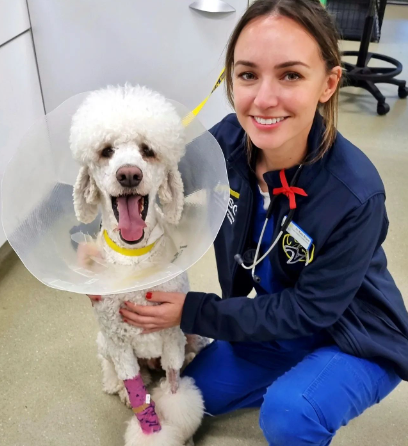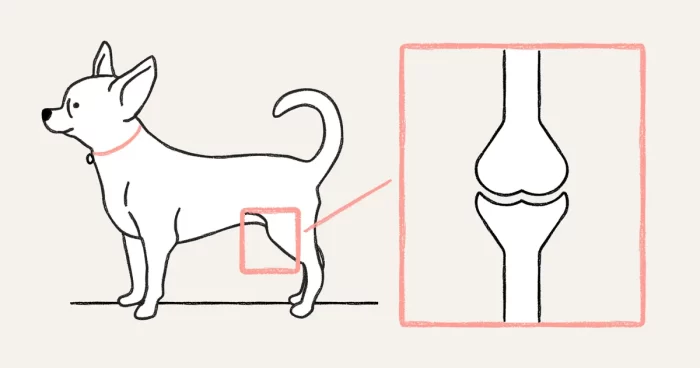Patellar luxation is a common orthopedic condition that affects the rear legs and knees of dogs, particularly small and toy breeds like Shih Tzus. In this condition, the patella, or kneecap, moves out of its normal groove in the knee joint. This causes pain, inflammation, and lameness in the affected leg. If left untreated, it can lead to early onset arthritis. In this article we talk about Shih Tzu Patellar Luxation.
Table of Contents
What Causes Patellar Luxation in Shih Tzus?
Patellar luxation is often present at birth and caused by developmental issues as the dog grows. Contributing factors include:
- Genetics: Patellar luxation has a strong hereditary component. Poor breeding practices that do not screen for joint issues propagate the problem in some bloodlines.
- Bone and muscle abnormalities: The groove that guides the patella may be too shallow or the muscles surrounding the knee joint can be weak. This allows the kneecap to slip out of place.
- Trauma: In some cases, a traumatic injury to the knee can cause acquired patellar luxation later in a dog’s life.
Grades of Patellar Luxation
Patellar luxation is graded from I to IV based on severity:
- Grade I: The kneecap slips out of place occasionally but the dog can reposition it themselves without assistance. There may be temporary limping after activity.
- Grade II: The patella luxates more frequently. The dog may need to stretch or shake the leg to relocate the kneecap. Intermittent lameness is common.
- Grade III: The patella stays luxated most of the time, only relocating with manipulation. The joint has developed arthritis. Lameness worsens over time.
- Grade IV: The kneecap is permanently dislocated and cannot relocate at all, leading to severe arthritis. The dog is lame even during rest.
Symptoms of Patellar Luxation in Shih Tzus
- Intermittent hind limb lameness, holding the leg up
- Difficulty straightening the knee, giving a bowlegged appearance
- Nonspecific signs like difficulty with stairs, jumping down, running and playing
- Pain or inflammation around the knee joint
- Arthritis developing over time
Some dogs only show clinical signs when the patella luxates. Others have persistent issues depending on the grade. Early detection and treatment is key to prevent the progression of arthritis.
Diagnosing Patellar Luxation
A veterinarian will diagnose patellar luxation through a physical exam and palpation of the knee joints. Signs like a bowlegged stance, loose kneecaps, and pain on manipulation help confirm the diagnosis. Additional tests may include:
- Radiographs (x-rays): Images of the knee joint show abnormalities in the patellar ridge, arthritis, and rule out other issues.
- Manual luxation testing: The veterinarian will manipulate the hind leg to feel where the kneecap slides and if it stays out of place. This determines the grade of luxation.
Treatment Options
Most dogs require surgery to realign and stabilize a luxating patella, especially those with persistent signs or high grades of luxation. Nonsurgical options include:
- Crate rest: Reducing activity prevents the kneecap from luxating as often.
- Anti-inflammatory medication: Drugs like carprofen provide pain relief and control inflammation.
- Joint supplements: Supplements with glucosamine, omega-3s and chondroitin support joint health.
- Weight management: Maintaining ideal body weight reduces stress on knee joints.
Surgical treatments may include:
- Deepening trochlear groove: Reshaping the patellar ridge makes it deeper to keep the kneecap in place.
- Tightrope technique: Special high strength suture material is threaded through drill holes in the femur and tibia to stabilize the joint.
- Tibial tuberosity transposition: The tibial crest is cut and moved to realign the pull of the quadriceps muscle on the patella.
Rehabilitation is crucial after surgery with controlled activity, physical therapy exercises, cold laser therapy and maintaining an ideal body condition score. With appropriate treatment, most dogs with patellar luxation can enjoy a good quality of life.
Preventing Patellar Luxation in Shih Tzus
Responsible Shih Tzu breeders should screen their breeding dogs for patellar luxation to reduce the prevalence in future generations. They should also follow these patellar luxation prevention tips:
- Perform OFA or PennHIP evaluations on parent dogs. Only breed dogs with healthy, low-risk hip and knee scores.
- Monitor puppy growth rate and body condition score. Overfeeding leading to rapid growth stresses developing joints.
- Provide proper nutrition with supplements and high quality proteins for muscle development.
- Give puppies developmentally appropriate exercise. Avoid too much running and jumping on developing joints.
- Correct abnormal hind leg angulation with harnesses instead of leash pressure on the neck.
Pet owners should also provide proper nutrition, maintain ideal body weight and give their Shih Tzu appropriate exercise to put minimal wear and tear on the knee joints as they age. With responsible breeding and conscientious joint care, patellar luxation severity and prevalence can be reduced in this beloved companion breed. I sincerely hope you find this “Shih Tzu Patellar Luxation-Understanding Joint Problems” article helpful.

Dr. Kate Bruce is a highly experienced veterinarian with a Master’s degree in Veterinary Medicine and over a decade of expertise in animal behavior and holistic pet care. She combines traditional and modern practices to offer exceptional advice on pet health and wellness. Explore more at petsconsultancy.com and follow her on Instagram for expert tips.









